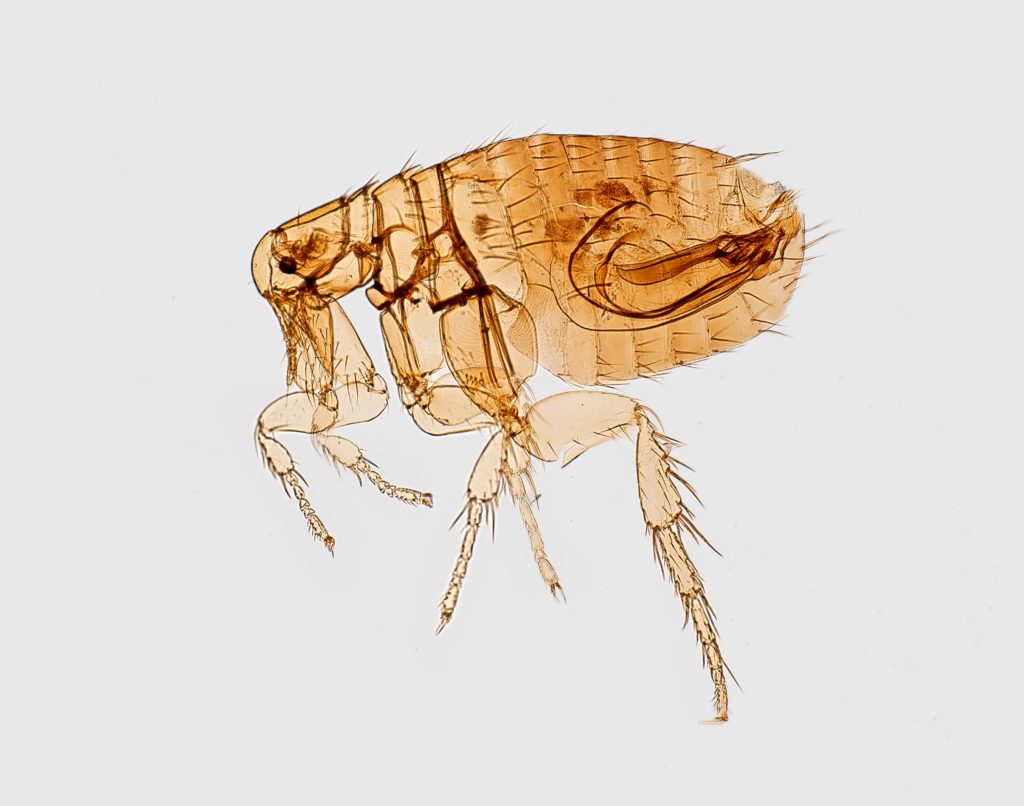
It’s been about four months since COVID-19 changed the way of life for countless people, and though this has brought about untold hardships, there is at least one ray of light to be found: pet adoptions and fostering have soared. With people spending so much more time at home and in some level of isolation, they have found themselves in the unique position of not only wanting a furry friend, but having the time to devote to taking care of the adorable balls of fur that brighten our days. As more homes find themselves occupied by adorable cats and dogs and the love they give, they may also soon find something else occupying their space: fleas.
Though COVID-19 has led to the drastic increase in pets finding homes, it has also left veterinary access considerably limited, which means that one of the best ways to keep a flea issue from exploding into a full-blown infestation has been drastically hampered. This is why it’s especially important to educate yourself on fleas, so you can get control of any potential issues, and keep you and your pets safe, healthy, and happy.
“But wait,” you may be thinking…
“I Don’t Have Pets, so Why do I Have Fleas?”
There are three main reasons you may have fleas in your home even if you don’t own or foster any pets.
- One of the most common reasons is due to rats, mice, and wildlife that can get into your yard or your home and bring their fleas with them.
- Flea pupae can lay dormant for up to a year if left undisturbed. This means that if a home or yard had a previous flea infestation that was never fully taken care of, and then the area wasn’t used for months (I.e. if it’s between rentals or being sold), when you begin to use that space again, the fleas will emerge and search out food.
- Though much less common, it is possible for fleas to take residence in your home if you had a friends pet in your house/yard for a fair bit of time; the flea eggs will inherently drop off the affected animal and end up in your home.

What do Fleas Look Like?
There are about 2,500 species of fleas world-wide, with around 325 of those found in the continental U.S.; most of these fleas are found on mammals, but there are some that are more specific to birds. The most common species you are likely to interact with is the cat flea; this is the predominant type of flea that will infest pets (yes, both dogs and cats) and livestock, and therefore the most likely to end up biting humans.
Adult fleas are about 1/8 inch long, have a thin oval-shape body, large hind legs (used for jumping), are reddish-brown in color, and are wingless. Flea larvae look a bit like tiny whitish worms but are so small you are unlikely to recognize them without the aid of a microscope. Even more difficult to distinguish are flea pupae, which generally cannot be spotted with the naked eye because they are encased in a sticky cocoon that gets covered by small bits of debris in their environment, acting essentially as camouflage.
Where are Fleas Found?
Since adult fleas require a blood meal from an animal, you are most likely to find them in areas regularly frequented by animals, whether indoors or outdoors. Indoors, they are most likely to be found in pet bedding, in carpets, in upholstered furniture, and even in your blankets (if you allow your pets on your bed). Outdoors, they are most commonly found in crawlspaces under your home, in shaded areas (especially those frequented by pets), and in cracks and crevices of walkways and porches. However, it is important to note that flea larvae are sensitive to both humidity and temperatures; if the humidity drops below 45% or the temperature of the area they are in exceeds 95° F, they cannot survive.

How do I Know if I Have Fleas?
There are a few tell-tale signs of a flea infestation:
- Your pet is scratching/biting at itself. Not only do fleas cause pain and irritation when they bite, but their salivary glands secrete an irritating substance that generally causes the site to itch. This irritation and subsequent scratching can even lead to patches of fur-loss. In addition, if you look at their skin where the scratching is happening, you will see small raised red dots (flea bites).
- You see them. The first place you are likely to notice them is on your pet, particularly while grooming or petting them, and especially if your pet has light-colored fur. If you start to see them in your carpet or jumping around (they can jump around 12” upward and horizontally), there is a good chance the infestation has gotten out of control. A good rule of thumb is that for every adult flea you see, there are probably 100 (or more!) flea larvae/pupae around.
- There is a simple test you can do to see if you are having flea activity in your home or yard: put on tall white socks and slowly walk around, keeping an eye on the socks. With the stark contract between the white sock and the dark flea, you are much more likely to notice them. If the idea of seeing the fleas on you is unappealing, you can also place a couple sheets of white printer paper in areas regularly frequented by your pets and watch them to see if any fleas hop onto them.
- You see “flea dirt”. “Flea dirt” is essentially the excrement of adult fleas and consists of bits of dried blood. It looks a bit like black pepper and can generally be found on your pet’s skin, bedding, and carpet.
What do Fleas Feed on?
Adult fleas consume blood meals from warm-blooded animals, consuming up to 15 blood meals per day. They prefer to feed on furry animals and are generally most successful when feeding from those with long hair. This is because once they jump onto a host they will both consume their meals and reside on the host for as long as they can. When furry animals aren’t an option though, they will feed on humans, particularly attacking the ankle and calf areas.
Flea larvae feed on particles of organic matter, namely “flea dirt” and pet feces.

How Long do Fleas Live?
A standard flea life cycle can be as short as 21 days or as long as a year. But why is there such a significant discrepancy in the length of it’s lifespan? The answer is that environmental conditions play a significant part in determining how long a flea can survive, with more hospitable conditions (i.e. readily available food sources, a temperate climate, and high humidity) helping a flea to move through their stages faster, but with more adverse conditions causing the flea to remain dormant in its pupal stage until such times as the conditions improve, up to 1 full year.
This means that if conditions are poor, you could end up harboring pupal fleas for months before suddenly having an emergence. Conversely, if conditions are favorable, you could see a flea infestation get out of control fairly quickly, as females begin laying their eggs within just 48 hours of their first feed, and they can lay around 25-40 eggs per day, or about 2,000 eggs in their lifetime.
Are Fleas Dangerous?
The most common danger from cat fleas is to your pets and ranges from: tapeworm, anemia (especially in small animals), and skin infections (from an allergic reaction to the fleas, as well as an increased potential secondary infection of any skin that was damaged due to scratching). However, these fleas can also pose a health risk to humans, which issues ranging from cat scratch disease, to flea-borne spotted fever, to tapeworms (especially in your children). Still, cat fleas are not the most dangerous species of flea for humans, with species like the Oriental rat flea being a primary vector for the plague.

How do you Treat for Fleas?
Because of the potential for a long dormancy period, it’s important that you get fleas professionally treated, because licensed technicians have access to a product called an Insect Growth Regulator (IGR) that can help you overcome this hurdle. What that product does is prevent the fleas from reproducing once they reach adulthood, so all of the egg, larvae, and pupal fleas hanging out in your home will be the very last of the fleas you will have from this infestation. Simply using an instant-kill product alone won’t eliminate the infestation.
It’s also important to get fleas treated at the first signs of trouble, before their numbers get fully out of control. So as soon as you notice fleas in your home or yard, call The Bug Dude at 817-354-5350 and let our technicians help you get rid of these pests before they take over.
When you call The Bug Dude to set your treatment appointment, our staff will walk you through the prep work that will need to be done prior to the treatment. In brief, that prep is: vacuuming all carpeted areas and upholstered furniture (and throwing away the vacuum bag in an outdoor trash can), cleaning all pet bedding in hot water, mowing the yard, and clearing all areas where treatment will be performed (i.e. floors and the yard). You and your pets will also need to the leave the home and yard until the products have dried fully (around 3 hours). Finally, your pets need to be treated for fleas; if they are already being treated then you’re in good shape for this, otherwise we recommend taking them to be treated at the same time your home/yard is being treated.
Can you Prevent Fleas?
Unfortunately there is no way to fully prevent fleas from invading your home. The most important things you can do is keep your pets on a regular flea preventative program, keep all areas frequented by your pets nice and clean, and keep your eyes out for any of the signs of an infestation.
Fleas are more than just a nuisance pest, and can greatly impact the quality of life for your pets and for you. With everything going on in the world right now, don’t let fleas make your home one more place of stress, just give The Bug Dude a call at 817-354-5350 and let our expert technicians help give you some peace of mind.
Further Reading:
“‘The call has been answered’: Animal shelters across the U.S. are emptying amid coronavirus pandemic” – Cameron Oakes – NBC News
“How to Spot the Signs of Fleas” – WebMD Veterinary Reference – Reviewed by Amy Flowers, DVM
“Controlling Fleas” – Mike Merchant & James Robinson – Texas A&M AgriLife Extension
“Flea Control and Prevention” – Michael F. Potter, Extension Entomologist – University of Kentucky College of Agriculture
“Fleas” – Purdue University Medical Entomology
“Fleas” – DPDx-Laboratory Identification of Parasites of Public Health Concern – Centers for Disease Control and Prevention
Author Bio: Alissa Breach has been gaining knowledge and experience around pest control concerns over the last 11 years while working for Mid-Cities Pest Control. She has a creative writing BA from UW-Madison and is always pursuing new and interesting writing projects.
Photo by CataventoProd
Photo by CDC
Photo by Brooke Lark




